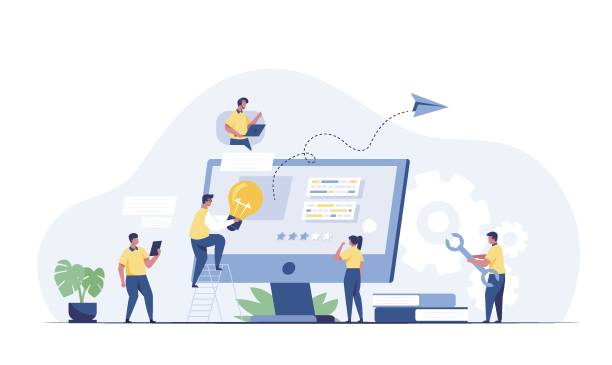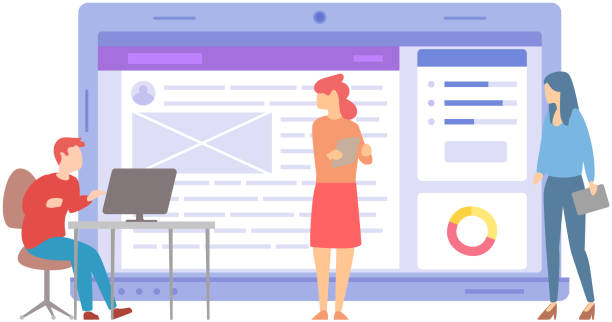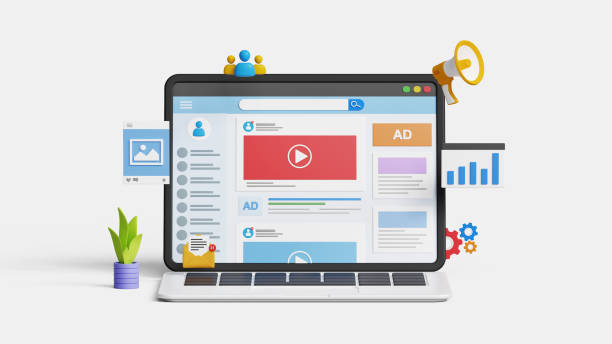The Fundamental Importance of Secure Website Design in the Digital Age

In today’s world, where digital boundaries are rapidly expanding, secure website design is no longer an option but an undeniable necessity.
With the increasing number of online users and transactions, websites have become attractive targets for #cyber_attacks.
Therefore, focusing on cybersecurity in the early stages of website development plays a vital role in protecting sensitive user data and maintaining business credibility.
An insecure website can lead to the loss of personal, financial, and even confidential information, which not only harms users but also inflicts irreparable damage to a brand’s reputation and #public_trust.
The discussion of data protection and #user_privacy is one of the most important concerns for individuals and organizations worldwide today, and websites, as the main point of contact, must be protected against threats in the best possible way.
This is an explanatory topic aimed at elucidating the fundamental reasons behind the need for web security.
Creating a secure website requires a deep understanding of potential vulnerabilities and the implementation of proactive defensive solutions.
Without a strong security framework, every website is at risk of security breaches.
Furthermore, secure website development ensures that data is protected during transmission and storage, which is particularly important for businesses dealing with sensitive information.
Therefore, attention to security aspects from the initial design phase is an investment in the long-term stability and success of your web project.
Failure to address this issue can lead to significant costs due to data breaches and legal penalties.
Does your current e-commerce website design not achieve the expected sales for you?
Rasawb is an expert in professional e-commerce website design!
✅ An attractive and user-friendly website aimed at increasing sales
✅ High speed and security for an ideal shopping experience⚡ Get a free online store design consultation with Rasawb!
Familiarity with Common Web Threats and Prevention Methods

On the path to secure website design, a precise understanding of common web threats and attacks is the first vital step.
This educational section helps you become familiar with the most common vulnerabilities and learn how to protect your website against them.
Attacks such as SQL Injection, where attackers inject malicious code into the database to gain unauthorized access to information, or Cross-Site Scripting (XSS), which allows an attacker to inject malicious client-side scripts into legitimate web pages, are just two examples of these threats.
Other attacks such as Cross-Site Request Forgery (CSRF), Denial-of-Service (DoS/DDoS) attacks, and Brute Force attacks can also disrupt your website’s performance or gain access to sensitive information.
To counter these threats, numerous preventive measures exist.
For example, to prevent SQL Injection, one should always use parameterized queries or ORM (Object-Relational Mapping) to ensure user inputs are not treated as executable code.
To counter XSS, all user inputs must be properly filtered and encoded before being displayed on the page.
Implementing CSRF tokens, rate-limiting requests to prevent Brute Force attacks, and using a WAF (Web Application Firewall) to counter DoS/DDoS are all part of comprehensive website hardening strategies.
Understanding these weaknesses and knowing how they are exploited helps developers make more informed decisions when coding and configuring servers.
This is fundamental knowledge that helps ensure a secure website platform.
Principles of Secure Coding and Layered Architecture

Secure website design goes beyond installing a few security plugins; this process begins at the core of coding.
This specialized section examines the principles of secure coding and the importance of layered architecture in web development.
One of the most important principles is ‘input validation’; this means that no user input should be used directly without thorough checking and filtering.
All data, whether from forms, URLs, or cookies, must be validated to prevent code injection or data manipulation.
Another principle is the ‘principle of least privilege’; this means that each component, service, or user should only have access to the minimum resources and permissions necessary to perform its task.
This limits the extent of damage in the event of a security breach in one section.
Layered architecture is also a critical approach in which the system is divided into several distinct layers (e.g., presentation layer, business logic layer, and data layer).
This separation not only simplifies management and development but also enhances security; each layer can have its own specific security mechanisms, and an attacker must bypass multiple security barriers to access deeper layers.
For example, the presentation layer should not communicate directly with the database but should send its requests through the business logic layer.
This separation of responsibilities significantly contributes to the stability and security robustness of the system.
Secure coding practices such as using Prepared Statements for database queries, encrypting sensitive information, proper error handling and secure logging, and utilizing reputable security frameworks with built-in security features all contribute to enhancing the website’s security level.
Using standards like OWASP Top 10 as a guide can help development teams identify and mitigate common vulnerabilities, thereby delivering a website with a higher level of secure development.
| Principle | Description | Example Application |
|---|---|---|
| Input Validation | Never trust user inputs; always validate and filter them. | Filtering special characters in forms, checking data type. |
| Principle of Least Privilege | Each component or user should only have access to the minimum permissions required for their tasks. | Granting read-only access to a database user for specific operations. |
| Secure Error Handling and Logging | Sensitive information should not be displayed in error messages, and logs should be securely maintained. | Using generic error messages for the user, storing details in a secure log file. |
| Data Encryption | Sensitive data in transit and at rest must be encrypted. | Using HTTPS, encrypting passwords in the database. |
The Role of SSL/TLS Certificates in Strengthening Website Security

One of the most fundamental yet critical steps in secure website design is the implementation of SSL/TLS certificates.
This guide section addresses the importance of these protocols in establishing a secure connection between the user’s browser and the website server.
SSL (Secure Sockets Layer) and its newer, improved version, TLS (Transport Layer Security), are protocols used to encrypt data transmitted over the internet.
When a website uses HTTPS (the secure version of HTTP using SSL/TLS), all information exchanged between the user and the server, including usernames, passwords, credit card details, and other sensitive data, is transmitted in an encrypted format.
This encryption prevents potential attackers from eavesdropping on or tampering with data in transit (man-in-the-middle attacks).
The presence of a green padlock in the browser’s address bar and the HTTPS prefix assures users that their connection is secure and their information is protected against threats.
This not only builds user trust but also offers SEO benefits, as search engines like Google prefer HTTPS websites in their search rankings.
Choosing the appropriate SSL certificate (such as DV, OV, EV) depends on the level of assurance you intend to provide to your users.
For most small and medium-sized websites, a DV (Domain Validation) certificate is sufficient, but for larger businesses or financial websites, OV (Organization Validation) or EV (Extended Validation) certificates, which include a higher level of validation, are recommended.
Therefore, data encryption and the use of these security protocols are considered a solid foundation for any modern and secure website.
Are you lagging behind large online stores in competition?
Rasawb, with professional e-commerce website design, brings your business online and increases your market share!
✅ Increased brand credibility and customer trust
✅ Easy shopping experience leading to more sales
⚡ Take action now for a free website design consultation!
Database Management and Security: A Critical Step in Secure Website Design

The database is the heart of every website, storing valuable data.
Therefore, secure website design would be incomplete without special attention to database security.
This analytical section addresses the importance of database management and protection.
Database attacks, such as SQL Injection, can lead to the leakage of sensitive data, alteration of information, or even their complete deletion.
To protect the database, multiple security layers must be implemented.
Firstly, using strong and unique passwords for database user accounts and changing them regularly is essential.
Secondly, the principle of least privilege must also be observed here; meaning that any application or user accessing the database should only have the minimum necessary permissions (e.g., read-only or write access to specific tables).
Preventing direct database access via the internet and limiting access only to valid IP addresses or internal web servers creates an important defensive layer.
Encrypting sensitive data stored in the database, especially personal or financial information, prevents its misuse even if data is leaked.
This encryption can be applied at the column, table, or entire database level.
Continuous monitoring of database activities and logging security events to identify suspicious patterns or unauthorized access attempts is crucial.
These logs can help identify and respond quickly to threats.
Also, regularly updating database software to the latest stable and secure versions is essential to address known vulnerabilities.
With a deep understanding of database architecture and the implementation of multi-layered security solutions, greater confidence can be achieved in the security of information stored within it.
User Authentication and Access Management

Authentication and access management systems are the backbone of secure website design, as they are the first point of contact for users and simultaneously the primary target for attackers.
This section entertainingly discusses the importance of creating strong authentication systems and managing user access.
Think of user passwords as the keys to their homes; the simpler the key, the easier it is for thieves to enter! Therefore, encouraging users to use complex and long passwords, and implementing strong password policies (including minimum length, use of uppercase and lowercase letters, numbers, and symbols) is essential.
But passwords are just one layer of security.
Two-factor authentication (2FA) or multi-factor authentication (MFA) goes a step further and provides a much stronger defensive layer.
This mechanism, in addition to the password, requires another verification factor (such as a code sent to a mobile phone or a fingerprint), ensuring the account remains secure even if the password is compromised.
Access management is equally important.
Every user, whether a regular user or a site administrator, should only have access to the parts of the website necessary for their tasks (principle of least privilege).
This means that a regular user should not have access to administrative settings or sensitive database sections.
Implementing User Roles and precise management of access levels prevents internal security issues.
Monitoring unsuccessful login attempts and temporarily blocking suspicious IP addresses can help prevent Brute Force attacks.
These security systems not only prevent attacker infiltration but also provide a safer user experience and reinforce a sense of trust among users, which is a positive aspect of secure website design.
Regular Updates and Security Patches: A Fundamental Solution

In the ever-evolving world of cybersecurity, secure website design is not a static process; rather, it requires continuous maintenance and updating.
This news section addresses the critical importance of regular updates and applying security patches.
As technology news shows, new vulnerabilities are discovered daily in software and frameworks used on websites.
Hackers quickly exploit these vulnerabilities to infiltrate systems.
Therefore, it is the responsibility of website administrators to always use the latest versions of Content Management Systems (CMS), plugins, themes, coding libraries, and even server operating systems and database software.
Software development companies release security patches that address these flaws as soon as a vulnerability is discovered.
Failure to apply these patches promptly leaves your website vulnerable to known attacks.
Delaying updates is like leaving your front door open and expecting no one to enter! A prominent example of this importance is the widespread vulnerabilities discovered in the past in software like Apache Struts, Heartbleed in OpenSSL, or Log4Shell in Apache Log4j.
These vulnerabilities allowed hackers to easily infiltrate systems, and websites that were not updated suffered significant damage.
A regular schedule for checking and applying updates should be an integral part of a website’s security maintenance strategy.
This not only protects your website from attacks but also improves its performance and ensures compatibility with new technologies.
| Section | Importance of Update | Recommended Frequency |
|---|---|---|
| Content Management System (CMS) | Fixing vulnerabilities, improving performance and features. | Upon release of new versions or security patches. |
| Plugins and Themes | Addressing specific security weaknesses of each plugin/theme. | As soon as updates are available from the developer. |
| Server Operating System | Strengthening server infrastructure security and fixing system bugs. | According to the regular schedule of the operating system and its distribution. |
| Database Software | Data protection, improving database stability and performance. | Upon release of new stable versions. |
| Libraries and Frameworks | Preventing attacks based on fundamental code vulnerabilities. | Regular review and update to the latest versions. |
Backup and Disaster Recovery Strategies

Even with the best secure website design approaches, the probability of unfortunate incidents such as successful cyberattacks, hardware failures, or human error never reaches zero.
This guide section focuses on the critical importance of Backup and Disaster Recovery strategies.
Regular and comprehensive backup of all website data, including files, databases, and server configurations, is your first line of defense after an incident occurs.
Imagine if your website’s data were completely lost or encrypted by ransomware; having a reliable backup could be the difference between bankruptcy and the continued existence of your business.
It is recommended that backup copies be stored in separate and secure locations; for example, one copy on a local server, one in the cloud, and one physical copy elsewhere.
This ‘3-2-1’ strategy ensures that even if one storage location is lost, your data remains accessible.
However, merely having a backup is not enough.
A disaster recovery plan includes a set of procedures and protocols for rapidly and efficiently restoring the system to an operational state after an incident.
This plan should include steps such as identifying the type of disaster, assessing damage, restoring data from backups, and rebuilding the system.
Data recovery and regular testing of the disaster recovery plan are also of high importance.
Without testing, you cannot be sure that your plan will work correctly in a moment of crisis.
This proactive approach to system stability and ensuring minimal website downtime is an indispensable part of a comprehensive web security strategy.
Did you know that 94% of users’ first impressions of a business are related to its website design? With professional corporate website design by **Rasawb**, turn this first impression into an opportunity for growth.
✅ Attract more customers and increase sales
✅ Build credibility and trust in the eyes of the audience⚡ Get a free website design consultation now!
Continuous Monitoring and Security Incident Response

After implementing all preventive measures in secure website design, the next stage is continuous monitoring and the ability to respond quickly to security incidents.
This specialized section addresses the importance of establishing an efficient monitoring system and planning for security incident response.
Websites, like any other online system, are constant targets of attacks, and even the best defenses can sometimes be breached.
Monitoring tools such as Security Information and Event Management (SIEM) systems or server and network activity monitoring tools can help identify suspicious patterns, intrusion attempts, or unusual activities.
These tools collect and analyze logs from various sources (servers, firewalls, web applications), issuing real-time alerts.
For instance, if a large number of unsuccessful login attempts are observed from a specific IP address, or if critical system files are altered without permission, the monitoring system should issue an alert.
Having a team or individual responsible for Incident Response is essential.
This team should have defined protocols for handling each type of incident, from identifying and containing the threat to eradication and recovery.
Every security incident must be documented so that its lessons can be used to improve security monitoring and strengthen future defenses.
Planning for various attack scenarios, training the team, and conducting incident simulation exercises help prepare for reality.
This continuous process not only helps maintain security but also minimizes downtime and ensures data accessibility and integrity.
The Future of Secure Website Design and Upcoming Challenges

The future of secure website design is a path filled with new challenges and innovative opportunities.
This thought-provoking section explores future trends and how web security will evolve in response to increasing threats.
With advancements in technologies like Artificial Intelligence (AI) and Machine Learning (ML), attackers will be capable of more sophisticated and automated attacks.
On the other hand, these very technologies can become powerful tools for defense, for example, in identifying suspicious behavioral patterns or predicting attacks.
But can AI alone guarantee complete security? Certainly not, because human ingenuity in discovering vulnerabilities will always be one step ahead.
Blockchain and Distributed Ledger Technologies (DLT) also hold significant potential in improving data security and integrity, especially in areas such as decentralized authentication or tracking data changes.
However, their widespread implementation in existing web infrastructures will entail its own scalability and complexity challenges.
This means advanced web security requires hybrid and innovative approaches.
Another challenge is the increasing complexity of the web ecosystem; with the emergence of microservices, numerous APIs, and inter-system dependencies, potential entry points for attacks also increase.
Cloud security, Internet of Things (IoT) device security, and data privacy protection (such as GDPR or CCPA) will also become key topics in the future of web security.
Are we ready to face these challenges and build a website that is both user-friendly and resilient against future attacks? Only with a continuous approach to learning, innovation, and collaboration between security experts and developers can we ensure the future of secure website design.
Frequently Asked Questions
| Question | Answer |
|---|---|
| 1. What does secure website design mean? | Secure website design means creating a website that is resistant to cyberattacks and protects user and server information. |
| 2. Why is security important in website design? | To prevent data breaches, maintain user privacy, preserve user trust, and avoid financial and reputational losses. |
| 3. What are the most common web vulnerabilities? | SQL Injection, Cross-Site Scripting (XSS), Cross-Site Request Forgery (CSRF), Broken Authentication, and Security Misconfiguration. |
| 4. How can SQL Injection be prevented? | By using Prepared Statements / Parameterized Queries, ORMs, and Input Validation. |
| 5. What is the role of HTTPS and SSL/TLS in website security? | HTTPS, using the SSL/TLS protocol, encrypts communication between the user’s browser and the server, preventing eavesdropping and data tampering. |
| 6. What measures should be taken to prevent XSS attacks? | Input Validation, Output Encoding to prevent malicious code execution, and using Content Security Policy (CSP). |
| 7. What does a strong password policy include? | Enforcing long passwords, a combination of uppercase and lowercase letters, numbers, and special characters, and preventing reuse. |
| 8. How does two-factor authentication (2FA) help security? | Even if the user’s password is compromised, the attacker cannot access the account without the second authentication factor (such as an SMS code or an app). |
| 9. What is a Web Application Firewall (WAF) and what is its use? | A WAF is a firewall that monitors and filters HTTP traffic between a web application and the internet to prevent common web attacks like SQL Injection and XSS. |
| 10. Why is regular updating of software and libraries important? | Updates often include security patches to fix discovered vulnerabilities. Failure to update can expose the site to new attacks. |
And other services of Rasawb Advertising Agency in the field of advertising
Smart Digital Branding: Designed for businesses seeking campaign management through key page optimization.
Smart Custom Software: Transform campaign management with the help of intelligent data analysis.
Smart Direct Marketing: A dedicated service for increasing user engagement based on intelligent data analysis.
Smart Customer Journey Map: A novel service for increasing click-through rates through key page optimization.
Smart Customer Journey Map: Designed for businesses looking to analyze customer behavior through attractive UI design.
And over hundreds of other services in the field of internet advertising, advertising consultation, and organizational solutions
Internet Advertising | Advertising Strategy | Advertorials
Resources
Secure Website Design
Website Performance Improvement
Website Security Optimization
Complete Web Design Guide
? Lead your business to digital success with Rasawb Digital Marketing Agency. From custom website design to SEO optimization and advertising campaign management, we are with you every step of the way to ensure a powerful and impactful online presence. Contact us for consultation and to begin your business’s digital transformation.
📍 Tehran, Mirdamad Street, next to Bank Markazi, Southern Kazeroon Alley, Ramin Alley, P.O. Box 6

